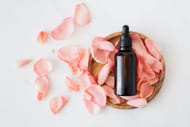Taking care of oily skin can be a challenge, but with the right skincare routine, you can keep excess oil at bay and achieve a healthy, balanced complexion. Oily skin is characterized by the overproduction of sebum, which can lead to clogged pores, acne breakouts, and a shiny appearance.
However, with a consistent and targeted approach, you can maintain a clear and matte complexion. In this article, we will provide you with a step-by-step guide to a skincare routine specifically designed for oily skin.

Comprehensive Guide to Skincare Routine for Oily Skin
Here is the ultimate skincare routine for oily skin, designed to banish excess oil and promote a clear, balanced complexion. Follow these steps to achieve a shine-free and radiant look that will leave you feeling confident all day long.
1) Cleansing: Removing Impurities
Cleansing is the foundation of any skincare routine, especially for oily skin. It helps to remove dirt, excess oil, and impurities that can clog your pores. Look for a gentle cleanser specifically formulated for oily skin.
Avoid harsh soaps or cleansers that strip the skin of its natural oils, as this can trigger more oil production. Massage the cleanser onto damp skin in circular motions, then rinse thoroughly with lukewarm water. Pat your face dry with a clean towel.

2) Toning: Balancing the Skin
Toning is an essential step in an oily skincare routine as it helps to balance the skin's pH levels and control excess oil. Opt for an alcohol-free toner that contains ingredients like witch hazel or tea tree oil, known for their astringent properties.
Apply the toner to a cotton pad and gently swipe it across your face, focusing on the T-zone and other oily areas. This will help tighten the pores and reduce oiliness.
3) Exfoliating: Removing dead skin cells
Exfoliation is crucial for oily skin to prevent clogged pores and remove dead skin cells. Choose a gentle exfoliator with salicylic acid or glycolic acid, which are effective in unclogging pores and controlling oil production.
Be cautious not to over-exfoliate, as it can lead to skin irritation and increased oiliness. Use the exfoliator twice a week, massaging it onto damp skin in circular motions. Rinse thoroughly and follow up with a toner.
4) Treating: Targeting specific concerns
Oily skin is often prone to acne and blemishes. To address these concerns, incorporate targeted treatments into your skincare routine. Look for products containing ingredients like benzoyl peroxide or tea tree oil, which have anti-inflammatory and antibacterial properties.
Apply the treatment directly to the affected areas, avoiding the rest of the face to prevent dryness. Allow the treatment to absorb fully before proceeding to the next step.
5) Hydrating: Balancing moisture
Contrary to popular belief, oily skin still needs hydration. Lack of moisture can actually trigger more oil production as the skin tries to compensate for the dryness. Choose a lightweight, oil-free moisturizer specifically formulated for oily skin.
Look for ingredients like hyaluronic acid, which hydrate the skin without clogging pores. Apply a small amount of moisturizer to your face and gently massage it in upward motions until fully absorbed.

6) Protecting: Shielding from the sun
Sun protection is vital for all skin types, including oily skin. Excessive sun exposure can worsen oily skin and lead to premature aging. Opt for a non-comedogenic sunscreen with a broad-spectrum SPF of at least 30.
Apply it generously to your face, neck, and any exposed skin, even on cloudy days. Reapply every two hours, especially if you're outdoors or perspiring.
7) Makeup tips: Enhancing your natural beauty
If you wear makeup, choose oil-free or non-comedogenic products specifically designed for oily skin. Use a mattifying primer before applying foundation to control shine throughout the day. Look for lightweight, water-based foundations or mineral powders that won't clog your pores.
Avoid heavy or oil-based products that can exacerbate oiliness. Set your makeup with a translucent powder to further reduce shine and enhance its longevity. Carry blotting papers or oil-absorbing sheets with you to gently blot away excess oil during the day without disturbing your makeup.

8) Healthy habits: Supporting your skincare routine
In addition to a consistent skincare routine, adopting healthy habits can greatly benefit oily skin. Here are a few tips to keep in mind:
- Diet: Maintain a balanced diet rich in fruits, vegetables, and whole grains. Limit your intake of processed and greasy foods, as they can contribute to oiliness and breakouts.
- Hydration: Drink an adequate amount of water daily to keep your skin hydrated from within. Proper hydration helps maintain the skin's natural balance and can reduce oil production.
- Hands-off Approach: Avoid touching your face with unwashed hands, as it can transfer dirt, bacteria, and excess oil to your skin, leading to breakouts.
- Regular Exercise: Engage in regular physical activity to improve blood circulation and promote a healthy complexion. Remember to cleanse your face after exercising to remove sweat and impurities.
- Stress Management: High stress levels can trigger oil production and worsen skin conditions. Practice stress management techniques such as meditation, yoga, or engaging in activities you enjoy.

Establishing a skincare routine tailored to oily skin can help you achieve a balanced and healthy complexion. By following a step-by-step guide that includes cleansing, toning, exfoliating, treating, hydrating, and protecting, you can effectively manage oiliness and prevent common skin concerns.
Additionally, adopting healthy habits and using makeup products specifically designed for oily skin can complement your skincare routine. Embrace the journey towards radiant and shine-free skin by embracing these guidelines and making them a part of your daily routine. Remember, consistency is key in achieving the best results for your skin.
